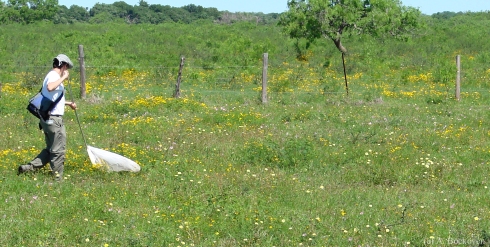Sweep netting is a simple technique with dramatic results in terms of bug collecting. The only tool required is an insect net–most sweep nets are made of a sturdy material, such as canvas, but with care a finer netting can be used. From there the technique is to sweep the net back and forth across the ground, through grass, forbs, and even shrubs. The opening of the net is turned quickly from side to side as the net sweeps, essentially following a shallow figure eight pattern.
The sweeper should walk quickly forward while sweeping, holding the net out as far in front as possible. This will help to catch insects that may startle and fly if given enough reaction time or approached too closely. The net is moved through plants and grasses with force, to help knock insects loose. This is why a sturdy fabric is important to prevent tearing. Sweeping continues for some distance–until the sweeper is tired of sweeping, or if too much plant material is accumulating in the net.
The net can be flipped over, with the bag hanging over the rim, to ‘seal’ the net, until contents can be examined. Above are the contents of a net after a quick sweep through some tall grass and forbs. Several spiders, stink bugs, and stick grasshoppers are easy to spot. How many bugs can you see?
—
Back to the techniques section.



Leave a comment